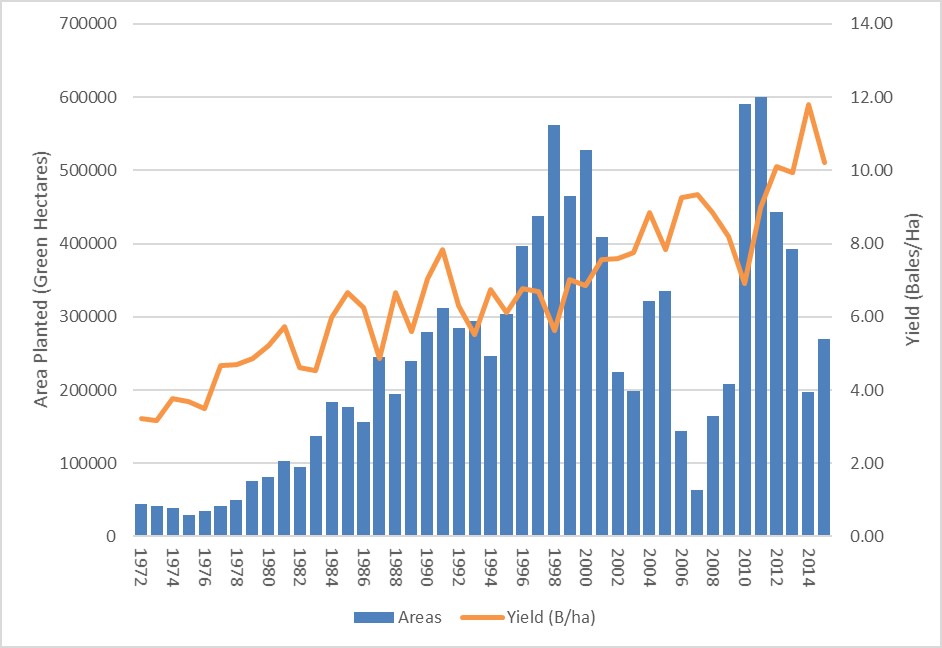FAQS
Dryland farming is dependent on natural rainfall. Whether the crop is cotton, sorghum or another option, yields can never be guaranteed. However, major advances in variety performance and technology traits have simplified the process of growing dryland cotton, reducing the risk and increasing the reward for growers.
On a yearly basis, the profitability of any crop will rise and fall due to market forces and seasonal conditions. However, dryland cotton, when examined over the full term of a rotational cycle, has consistently proven to provide the highest gross margin return. Read more about why growers are realising the benefits of growing dryland cotton.
Greater returns - over the rotation cycle compared with growers on solely grain-based rotations; 2016/17 saw prices of around $550/bale.
Less risk - current varieties and improvements in technology traits have simplified the process for growing dryland cotton. Yield potential is continually increasing and pests are more manageable with new technology traits.
Flexibility - cotton varieties incorporating Bollgard® 3 traits have facilitated greater flexibility in planting windows, reduced refuge area requirements and more flexible pupae busting requirements.
Cash flow management – The End Point Royalty payment option offered by Bayer allows for major costs to be pushed to the end of the season and growers only pay for what they pick.
Simplified weed management - rotating away from a cereal-based program with a broadleaf crop, such as dryland cotton allows the insertion of a disease and weed break into the crop rotation plan.
Longer crop maturity of cotton - gives a wider window to make use of late summer rainfall through January and February. Combined with the use of skip row, this allows the plants to hold on for longer during dry periods.
Have a look at ways you can incorporate cotton into your dryland rotation.
The vigorous tap root system of cotton means the roots explore much wider for moisture and nutrients. Wider row configurations are used to increase the total amount of soil moisture available to the plants. This extends the time before in-crop rainfall is required and making the most of available rainfall, and the crop less reliant on in-crop rainfall particularly in the first two to three months of its life.
Narrow row configurations are more popular in areas with higher and more reliable rainfall. There is also a strong relationship between row configuration and fibre quality especially for fibre length. In row configuration trials, fibre quality improved with wider row configurations.
Planting into standing stubble provides a better environment for establishment, extends the planting opportunity, improves the efficiency of rainfall capture, provides a home for beneficial insects and reduces the likelihood of sandblasting.
View which varieties are suited to your region based on your growing conditions.
Converting moisture into returns is the focus for all dryland cropping farmers. Dryland cotton offers one of the best gross margins for summer cropping. With a range of marketing options available, growing dryland cotton makes good business sense, and more and more broadacre growers are making the switch.
Advances in biotechnology have resulted in the need to use fewer insecticide sprays to manage pests meaning reduced labour, lower costs and a more manageable cash flow.
Plus, a new suite of high yielding and high quality varieties for dryland cotton are highly adapted for dryland production giving you the opportunity to maximise returns while minimising risks.
For more information on gross margins, check out the Australian cotton industry gross margin budgets - 2019-20.
The overall trend for average yields of dryland cotton in Australia has increased since the late 1980s.
As you can see from the chart below, the overall trend for average yields of dryland cotton in Australia has increased since the late 1980s. Variations in climatic conditions obviously affect each year’s yield and explain, at least in part, the occasional swings from one year to the next.

Source: CSIRO (2011)
Due to the nature of dryland farming, weather conditions have a significant impact on yields. This means that there is considerable fluctuation in results, however, it is clear that there has been a general trend of increasing yields.
Every Bollgard II® and Bollgard® 3 cotton crop must have an associated refuge crop - unsprayed cotton, unsprayed pigeon pea or sprayed cotton. The refuge produces large numbers of Bt susceptible Helicoverpa spp. moths, minimising resistance.
Cotton varieties incorporating Bollgard 3 traits have reduced refuge area requirements, which means that area and resources can potentially be dedicated to profitable crops.
For full details on refuge requirements, refer to the Resistance Management Plan.
Row configuration is the spacing between rows of cotton, such as single skip, double skip or super single. By choosing the right row configuration for your operation you can significantly increase profits and reduce risk for your dryland crop.
Cotton should only be planted on a full profile of moisture.
Double skip row configuration is best suited to drier profiles and hotter environments. However, it has an average yield potential of about 39% less than solid plant. Plants can be prone to lodging especially vegetative branches, which take advantage of the extra light available in the skip area.